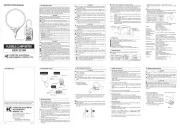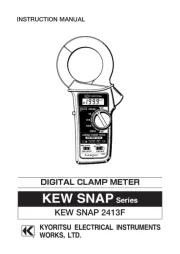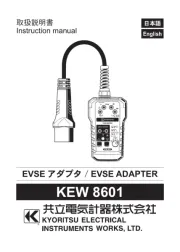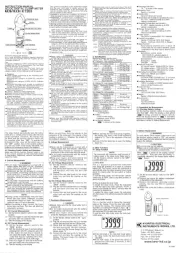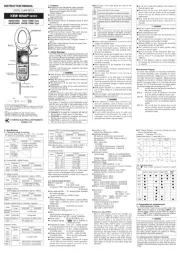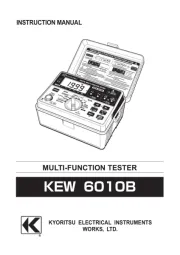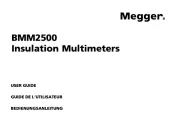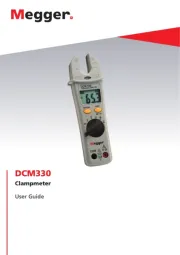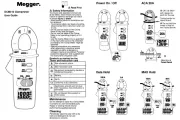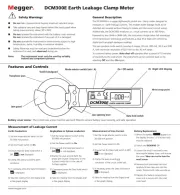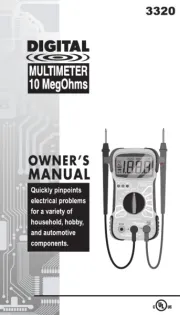
To avoid electric shock hazard, make sure to set
the function selector switch to "OFF" and remove
the test leads from the instrument before trying to
◦ Do not mix new and old batteries
◦ Make sure to install battery in correct polarity as
indicated inside the battery compartment.
is shown on the display, replace
the batteries. Note that when the battery is
completely exhausted, the display blanks without
(1) Set the function selector switch to the " " OFF
(2) Unscrew and remove the battery compartment
on the bottom of the instrument.
(3) Replace the batteries observing correct
polarity. Use two new R03 or equivalent
(4) Mount and screw the battery compartment
When shorting the test lead prods together,
the display may show a very small resistance
instead of "0." This is the resistance of the test
If one of the test leads has an open, the display
The instrument still consumes small amount of
battery power in the sleep mode. Make sure to
set the function selector switch to the " " OFF
This is a function to prevent the instrument
from being left powered on in order to conserve
battery life. This function causes the instrument to
automatically enter the sleep (powered down) mode
about 10 minutes after the last s
To exit the sleep mode, turn the function selector
switch back to " ", then to any other position, or OFF
(2) How to disable the sleep mode
To disable the sleep mode, Power the instrument
on with the data hold switch pressed. "P.OFF" is
shown on the display for about 3 seconds after the
instrument is powered on.
To enable the sleep mode, power the instrumen
off, then power it on without pressing the data hold
This is a function used to freeze the measured
value on the display. Press the data hold switch
to freeze the reading. The reading will be held
regardless of subsequent changes in input. "
shown on the upper left corner of the display while
the instrument is in the data hold mode.
To exit the data hold mode, press the data hold
If the instrument in the data hold mode enters
the sleep mode, the data hold mode will be
At DC 40A range, if the data hold switch is
pressed for more than 2 seconds, 0 ADJ.
When current flows from the upside to the
underside of the instrument, the polarity of the
reading is positive (+). Othewise, the polarity of
the reading is negative (-).
Never use the instrument on a circuit with a
voltage higher than 600 VAC/DC. Otherwise,
electric shock hazard or damage to the
instrument or the circuit under test may result.
Do not make measurement with the battery
compartment cover removed.
Keep your fingers and hands behind the
protective fingerguard during measurement.
6-1 AC Voltage Measurement
( )1 Set the function selector switch to the
the red test lead into the V/ terminal Ω
and the black test lead into the COM
( )3 Connect the test lead prods to the circuit
under test and take the reading on the
6-2 DC Voltage Measurement
( )1 Set the function selector switch to the
( )2 Plug the red test lead into the V/ terminal Ω
and the black test lead into the COM
( )3 Connect the test lead prods to the circuit
7. Resistance Measurement
Always make sure that the circuit under test is
Do not make measurement with the battery
compartment cover removed.
Keep your fingers and hands behind the
protective fingerguard during measurement.
( )1 Set the function selector switch to the
( )2 Plug the red test lead into the V/Ω terminal
and the black test lead into the COM terminal.
( )3 Check that the display reads "OL." with
the test lead prods shorted together,
also check that the buzzer beeps and the
( )4 Connect the test lead prods to the circuit
under test and take the reading on the
display. The buzzer beeps the reading is
AC/DC DIGITAL CLAMP METER
Protective fingerguard (Barrier):
It is a part providing protection against electrical
shock and ensuring the minimum required air and
Uncapped condition for CAT II environment Capped
condition for CAT III/ IV environments The Cap shuld
be firmly attached to the probes.
When the instrument and the test lead are
combined and used together, whichever lower
em belongs to will be applied.
◦Safety design conforming to the following provi-
Measurement category III 300V AC, pollution
Measurement category II 600V AC/DC, pollution
◦ Protected throughout by double or reinforced
insulation, indicated the International Electrical
"on the bottom of the instrument.
◦ Data hold switch for easy reading in dimly light
◦Sleepfeature to extend battery life.
◦Beeper permits easy continuity check.
Provides a dynamic range of 4,000 counts full scale.
This instruction manual contains warnings and
safety rules which must be observed by the user to
ensure safe operation of the instrument and retain
it in safe condition. Therefore, read through these
operating instructions before using the
Read through and understand instructions contained
in this manual before using the instrument.
◦ Save and keep the manual handy to enable
quick reference whenever necessary.
◦ The instrument is to be used only in its intended
Understand and follow all the safety instructions
Failure to follow the instructions may cause injury,
under test. Kyoritsu is by no means liable for any
damage resulting from the instrument in
contradiction to this cautionary note.
◦ Always make sure to insert each plug of the test
leads fully into the appropriate terminal on the
◦ Make sure to remove the test leads from the
instrument before making current measurement.
◦ Do not expose the instrument to the direct sun,
extreme temperatures or dew fall.
◦ Be sure to set the function selector switch to the
position after use. When the instrument will
not be in use for a long period of time, place it in
storage after removing the battery.
◦ Use a damp cloth and detergent for cleaning the
instrument. Do not use abrasives or solvents.
◦This instrument isn't dust & water proofed. Keep
away from dust and water.
Measurement categories (Over-voltage categories)
To ensure safe operation of measuring instrument
61010 establishes safety standards for various electrical
environments, categorized as O to CAT IV, and called
Higher-numbered categories correspond to electrical
environments with greater momentary energy, so a measuring
instrument designed for CAT III environments can endure
greater momentary energy than one designed for CAT II.
O : Circuits which are not directly connected to the
CAT II : Primary electrical circuits of equipment connected
to an AC electrical outlet by a power cord.
CAT III : Primary electrical circuits of the equipment
connected directly to the distribution panel, and
feeders from the distribution panel to outlets.
CAT IV : The circuit from the service drop to the service
entrance, and to the power meter and prima
overcurrent protection device (distribution panel).
Measuring Ranges and Accuracy
(at 23 ± 5 , 45-75% relative humidity℃ )
AC Current( )A Auto-ranging (50/60Hz)
DC Current( )A Auto-ranging
AC Voltage( )V Auto-ranging (50/60Hz)
DC Voltage( )V Auto-ranging
Resistance(Ω /Continuity)Auto-ranging
(Buzzer beeps below 50±35Ω)
Data Hold and 0 ADJ. Switch
Range Measuring Range Accuracy
Range Measuring Range Accuracy
Range Measuring Range Accuracy
Range Measuring Range Accuracy
Range Measuring Range Accuracy
The symbol indicated on the instrument means #
that the user must refer to related parts in the
manual for safe operation of the instrument. Be
sure to carefully read the instructions following
each symbol in this manual.#
DANGER is reserved for conditions and actions
that are likely to cause serious or fatal injury.
WARNING is reserved for conditions and
actions that can cause serious or fatal injury.
CAUTION is reserved for conditions and actions
that can cause minor injury or instrument damage.
Following symbols are used on the instrument and
in the instruction manual. Attention should be paid
ol to ensure your safety.
Refer to the instructions in the manual.
This symbol is marked where the user must
refer to the instruction manual so as not to
cause personal injury or instrument damage.
Indicates an instr ument with double or
Indicates that this instrument can clamp on
bare conductors when measuring a voltage
corresponding to the applicable Measurement
category, which is marked next to this symbol.
Th is i ns tr u me nt s at is fi e s t he m ar k in g
requirement defined in the WEEE Directive
(2002/96/EC). This symbol indicates separate
collection for electrical and electronic equipment.
◦ Never make measurement on a circuit with a
voltage higher than 600 V AC/DC.
Do not attempt to make measurement in the
presence of flammable gasses, fumes, vapor or
dust. Otherwise, the use of the instrument may
cause sparking, which can lead to an explosion.
◦ Transformer jaws are made of metal and
their tips are not insulated. Where equipment
under test has exposed conductive parts,
ially careful to avoid the hazard of
◦ Never attempt to use the instrument if its
surface or your hand is wet.
◦ Do not exceed the maximum allowable input of
◦ Never open the battery compartment cover
◦ Verify proper operation on a known source
before use or taking action as a result indication
protective fingerguard during measurement.
Never attempt to make any measurement if any
abnormal conditions are noted, such as broken
case, cracked test leads and exposed metal part.
◦ Do not turn the function selector switch with
plugged in test leads connected to the circuit
◦ Do not install substitute parts or make any
modification to the instrument. Return the
instrument to your distributor for repair or
◦ Do not try to replace the batteries if the surface
of the instrument is wet.
◦ Always switch off the instrument before opening
the battery compartment cover for battery
◦ Stop using the test lead if the outer jacket is
damaged and the inner metal or color jacket is
◦ Make sure that the function selector switch is
set to the appropriate position before making
OL. is shown on the display
About 2.5 times per second
◦ Temperature and Humidity for Guranteed Accuracy:
23 ± 5℃, relative humidity up to 85%
0〜40 , relative humidity up to 85%℃
◦Storage Temperature and Humidity :
-20 60 , relative humidity up to 85%〜℃
Two R03 or equivalent (DC1.5V batteries )
Approx. 15mA max. (ACA, DCA Range)
Approx. 5mA max. (ACV, DCV, Ω Range)
Automatically powered down in about 10
minutes after the last switch operation power (
consumption in the sleep mode is about 35μ )A.
IEC61010-1, -2-032, -2-033
CAT III 300V AC, pollution degree 2
CAT II 600V AC/DC, pollution degree 2
ges : 480A AC/DC for 10sec
AC voltage ranges : 720V AC/DC for 10sec
Resistance ranges : 300V AC/DC for 10sec
◦Operating Environmental Conditions :
Indoor use, Altitude up to 2000m
3470VAC( )RMS,50/60Hz for 5 seconds
between electrical circuit and housing case
10M or greater at 1000V between elect-Ω
Approx. 30 mm diameter max
187( )L x 68.5( )W x 38.5( )D mm
Approx. 200g(including batteries)
4. Preparation for Measurement
4-1 Checking Battery Voltage
Set the function selector switch to any position
. When the display is clear without
showing, proceed to measu-rement.
When the display blanks or
replaces the batteries according to the instructions
described in section 9. Battery Replacement.
The sleep feature automatically turns the instru-
ment off in a certain period of time after the last
switch operation. Therefore, the display may
be blank with the function selector switch set
to a position other than
instrument in this case, set the switch back to
position, then to the desired position,
or press any switch. If the display still blanks, the
batteries are exhausted. Replace the batteries.
4-2 Checking Switch Setting and Operation
Make sure that the function selector switch is set
to the correct position and the data hold switch
is deactivated. Otherwise, desired measurement
◦ Do not make measurement on a circuit with a
voltage higher than 600 V AC/DC. Otherwise,
shock hazard or damage to the instrument or
equipment under test may result.
◦ Transformer jaw tips are designed to minimize
the possibility of shorting conductors in the
circuit under test. If equipment under test has
exposed conductive parts, however, extra
precaution should be taken to avoid possible
◦ Do not make measurement with the battery
compartment cover removed.
◦ Do not make current measurement with the test
leads connected to the instrument.
◦ It is a part providing protection against electrical
shock and ensuring the minimum required air
and creepage distances. Keep your fingers and
hands behind the barrier during measurement.
During current measurement, keep the trans-
former jaws fully closed. Otherwise, accurate
measurement cannot be made. The maxi-mum
conductor size is 30 mm in diameter.
When measuring a larger current, the trans-
former jaws may buzz. This does not affect the
5-1 AC Current Measurement
( )1 Set the function selector switch to theACA
( )2 Press the trigger to open the transformer jaws
mp onto one conductor only.
( )3 Take the reading on the display.
5-2 DC Current Measurement
( )1 Set the function selector switch to the
( )2 With the transformer jaws closed and without
clamping them onto the conductor, press the
0 ADJ. Switch for more than 2 seconds to
zero adjust the display. (less than 2 seconds
: Data Hold Function operates.)The 0 ADJ.
Switch is enabled only on DC 40A range.
ger to open the transformer
jaws and clamp onto one conductor only.
( )4 Take the reading on the display.
